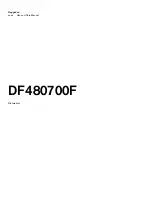
How to load the dishwasher
- 8 -
The illustration to next page shows the machine loaded
with five standard place settings. Your own dishes are
not likely to be identical to this load, but if you follow the
advice below we are sure you will be pleased with the
results.
• Always place glasses, cups and bowls upside down.
• Incline deep dishes (soup plates etc.) so that the
water can run off when drying.
• Make sure that the dishes do not rest against each
other. This is particularly important in regard to the
cutlery basket - nested spoons, etc. simply cannot be
properly washed. MAKE SURE THAT THE WATER
CAN GET AT ALL THE SOILED SURFACES.
• Make sure that cutlery with slender handles and other
items do not protrude through the openings in the
basket and prevent the spray arm from rotating.
• Never put silver and stainless steel objects together.
When these metals come into contact with each other
a chemical reaction occurs which stains the silver.
• China with a pattern applied on top of the glaze may
not be suitable for machine washing as the colours
may fade and lose their lustre. The same applies to
cutlery with wooden or plastic handles.
Always buy articles that are machine washable
in future.
• Not all plastic articles are machine washable. If you
are in doubt as to whether your plastic-ware can be
washed in the machine, we suggest you check by
washing a single item or else wash them by hand.
• Aluminium becomes dull and tarnished when machine
washed. The machine gets it clean, but at the expense
of its appearance.
• When washing delicate items, select the lower wash
temperature.
• Substances such as ketchup containing strong
colouring agents can cause temporary discoloration
in the machine.
Rack and basket
Cutlery basket
Dish rack






































